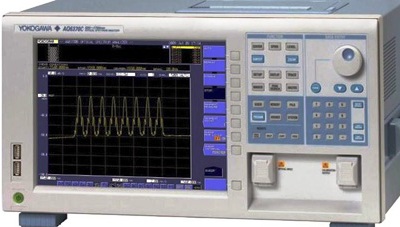
|
|
The Yokogawa AQ6370C Optical Spectrum Analyzer uses an advanced monochromator that achieves high wavelength resolution and high close-in dynamic range. With the sharper spectral characteristics of the monochromator, spectral signals in close proximity can be separated clearly and measured accurately. Measure a pulse peak spectrum of a pulsed light signal. Often used in the transmission loop testing of telecommunication systems, and also in the low power measurement at the early stage of laser chip development to catch the peak power of a pulsed signal. The AQ6370C’s wide close-in dynamic range allows accurate OSNR measurement of DWDM transmission systems. The built-in WDM analysis function analyzes the measured waveform and shows peak wavelength, peak level and OSNR of WDM signals up to 1024 channels simultaneously. The curve fit function is used to accurately measure noise levels. Specifications. Wavelength range: 600 to 1700 nm. Span. 0.5 nm to 1100 nm (full span), and 0 nm. Wavelength accuracy: ±0.10 nm (Full range). Wavelength linearity: ±0.01 nm (1520 to 1580 nm), ±0.02 nm (1450 to 1520 nm, 1580 to 1620 nm). Wavelength repeatability: ±0.005 nm (1 min.). Wavelength resolution setting: 0.02, 0.05, 0.1, 0.2, 0.5, 1 and 2 nm. Wavelength resolution accuracy: ±5% (1450 to 1620 nm, Resolution setting: = 0.1 nm, Resolution correction: ON, Number of sampling: AUTO). Min. sampling resolution: 0.001 nm. Number of sampling: 101 to 50001, AUTO. Level sensitivity setting: NORM_HOLD, NORM_AUTO, NORMAL, MID, HIGH1, HIGH2 and HIGH3. High dynamic mode: SWITCH (Sensitivity: MID, HIGH1-3). Level sensitivity: -90 dBm (1300 to 1620 nm), -85 dBm (1000 to 1300 nm), -60 dBm (600 to 1000 nm) (Sensitivity: HIGH3). Maximum input power: +20 dBm (Per channel, full range). Level accuracy: ±0.4 dB (1310/1550 nm, Input level: -20 dBm, Sensitivity: MID, HIGH1-3). Level linearity: ±0.05 dB (Input level: -50 to +10 dBm, Sensitivity: HIGH1-3). Level flatness: ±0.1 dB (1520 to 1580 nm), ±0.2 dB (1450 to 1520 nm, 1580 to 1620 nm). Polarization dependence: ±0.05 dB (1550/1600 nm), ±0.08 dB (1310 nm). Stray-light suppression ratio: 73 dB. Optical return loss: Typ. 35 dB (with angled-PC connector). Spec codes; 10: Standard model, 20: High performance model.
|